|
FAQs on Macrodactyla doreensis, Long
Tentacle Anemone Identification
Related Articles: LTAs, Anemones,
Bubble
Tip Anemones, Cnidarians, Coldwater Anemones, Colored/Dyed Anemones,
Related FAQs: Anemone ID 1, Anemone ID 2, Anemone ID 3, Anemone ID
4, Anemone
ID 5, Anemone ID
6,
Anemone ID 7,
Anemone ID 8,
Anemone ID 9, Anemone ID 10,
Anemone ID
11,
Anemone ID 12, Anemone ID 13, Anemone ID 14, Anemone ID 15,
Anemone ID
16, Anemone ID 17, Anemone ID 18, Anemone ID 19,
Anemone ID 20,
Anemone ID 21, Anemone ID 22, Anemone ID 23, Anemone ID 24, Anemone ID 25, Anemone ID 26, Anemone ID 27, Anemone ID 28, Anemone ID 29, Anemone
ID 30, Anemone ID 31,
Anemone ID 32,
Anemone ID 33,
Anemone ID 34, Anemone ID 35,
Anemone ID 36, Anemone ID 37, Anemone ID 38, Anemone ID 39, Anemone ID 40,
Anemone ID 42,
Anemone ID 43, Anemone ID 44,
Anemone ID 45,
&
Cnidarian
Identification,
Related FAQs: LTAs
1, LTAs 2, LTA Behavior, LTA Compatibility, LTA Selection, LTA
Systems, LTA Feeding, LTA Disease, LTA
Reproduction, Anemones 1,
Anemones 2, Anemones 3, Anemones
4, Bubble Tip
Anemones, Caribbean
Anemones, Condylactis, Aiptasia
Anemones, Other Pest
Anemones, Anemones and
Clownfishes, Anemone
Reproduction, Anemone
Lighting, Anemone Feeding,
Anemone Systems,
Anemone
Identification, Anemone
Compatibility, Anemone
Selection, Anemone Behavior,
Anemone
Health, Anemone
Placement,
Misplaced...
|
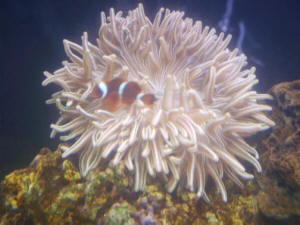
|
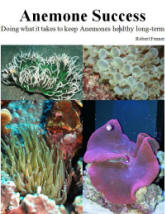 |
New Print and
eBook on Amazon:
Anemone Success
Doing what it takes to keep Anemones healthy long-term
by Robert (Bob) Fenner
|
|
anemone ID and care
4/26/12
Hi again crew hope you are all well.
<Hello Simon>
Can you please ID this anemone for me and give a little information on
care. i.e. flow rates, feeding, lighting etc. Also would it be a good
host anemone for my pair of Clarkii clowns?
<You have a Macrodactyla doreensis aka Long Tentacle Anemone and it is a
natural host for Clarkii Clowns. Read more here--
http://www.wetwebmedia.com/macrodoreensis.htm
http://www.wetwebmedia.com/ltasysfaqs.htm >
Thank you in advance
<Quite welcome>
Simon
<Jordan>
|
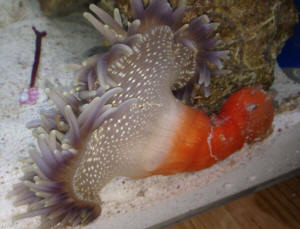 |
|
Re: Blue/Purple Aiptasia? 8/15/10
Hi Bob,
<Peter>
I was wondering if I could bother you with a few more questions
about this anemone?
<... have you read where you were referred? And here:
http://www.wetwebmedia.com/macrodoreensis.htm
and the linked files above>
I haven't been able to find many pictures or long-tentacle
anemones that look like this one so I am wondering if you could
confirm this ID and offer suggestions to get it into a larger
tank? I have a 46-gallon aquarium going with 200 watts of VHO
fluorescent lighting.
<Please read the above citations>
I scraped the glass on my aquarium and was able to take a better
picture.
Does this newer picture confirm a Macrodactyla doreensis as you
suggested based on the first pic?
<I do think so still>
If it is I would like to move it to the larger tank, if not... I
am open to suggestions!
With thanks,
Peter
<Welcome. BobF>
Re: Blue/Purple Aiptasia?
Bob,
One more pic. It shrunk a little and sure looked a lot
bluer...
Peter
<Very nice, though I'd get rid of the surrounding
Aiptasia. B>
|
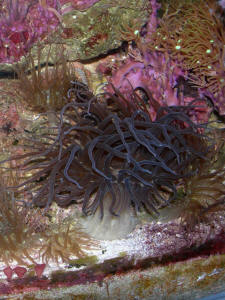 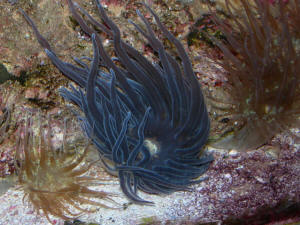 |
|
Anemone ID - 4/1/10
Hi Wet Web,
I was wondering if you could ID this anemone for me? I've
looked though the ID section but cannot find it. I've found
this anemone in the local fish store and its only being called a
sand anemone. It looks a bit like a Condy
but with very elaborate curls in each tentacle. The base is brown
and the tentacles go from vibrant pint to white, I've never
seen anything quite like it. Any ideas? and is this of the more
difficult variety to care for or about the same as a Condy.
kind regards
Lex
<I think this is a Macrodactyla doreensis... and a gorgeous
specimen!
Please read here: http://wetwebmedia.com/macrodoreensis.htm
and the linked files above re this species husbandry. Bob
Fenner>
|
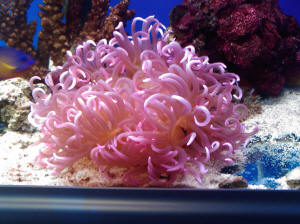 |
|
Long Tentacled Anemone?/Anemone ID
10/30/09
Hey guys!!
<Hello Scott>
Thanks again for all you do!!
<You're welcome.>
Wanted to check in with the experts! Saw this at a LFS and was
told it was a LTA. Resisted the urge to buy before doing some
research.
<Good.>
First question... is this correctly identified? It didn't
really look like the LTAs on WWM. Thanks for the help!! Any and
all info always appreciated!
<Appears to be a young Corkscrew/Long Tentacled Anemone.
I'm not so sure I'd purchase this specimen seeing that
dirty bubble up box filter they are using for filtration. Use
caution here especially if he has had this animal for a few days,
it may be on it's way out. A picture showing the oral
disc/mouth would have been better. James (Salty Dog)>
|
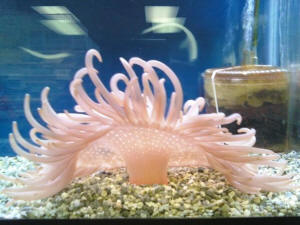 |
|
Bleached anemone follow up and id
8/11/2009
Hi Crew!
Hi Mr. Fenner!
<Claire>
Here I begin again to bother you with some questions...
One month ago, I sent you the picture of an anemone that you told
me being very badly bleached. It went into hiding and after one
week, I began to dismantle the rocks to find where it was. I
found it on a rock
under another rock, where I was unable to do anything for it. So
I moved a little bit the rock carefully and I began to feed it. I
bought smelt fish and raw shrimps and gave it a little bit of a
finely chopped mix
with tweezers or smelt fish and shrimps after blender with a
pipette.
After one week, I saw that it moved to be more accessible. And I
remarked that my first hermit (blue-legged) was trying to steal
the food from the anemone. I think that he damaged the oral disk
(reverse side )
because I saw 2 holes in the disk one day after when the anemone
was contracting the disk.
<This disc/mouth is fine>
So, from this moment, I feed the hermit at the same time I feed
the anemone and things are ok. Two days ago, one hour after
feeding, I saw that the mouth was like "everted" - a
bit like a ball - and then it came
back to a size more reasonable, but still gaping. I am pretty
anxious for the health of this anemone.
<It is much improved from your last report>
I send you three pictures of the anemone: the one I sent you
before (for comparison), the everted mouth from Friday and the
picture from today.
Please, could you tell me if it looks better to you and id it for
me? (I am lost between the Entacmaea quadricolor and other
kinds). I am feeding every two or three days.
<Is likely a LTA>
The other question is concerning ocellaris. I bought a couple a
juvenile ocellaris (farm-raised) and from a few days, they do not
even look at the anemone.
<Not atypical behavior from tank bred/reared clowns... May or
may not learn/communicate in time with the anemone>
They look mostly at the Caulerpa (really love it).
They do not accept food either. Do I have to feed them the same
food I feed the others or simply to be patient?
<Experiment... read here:
http://wetwebmedia.com/clnfdgfaqs.htm>
I tried to give them Spectrum Grow from New Life, they were
eating this at the LFS, but until now, I do not have any
success.
Thanks for your wonderful sharing of knowledge,
Claire
<A pleasure. Bob Fenner>
|
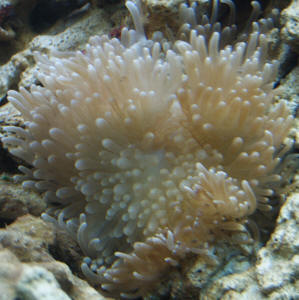 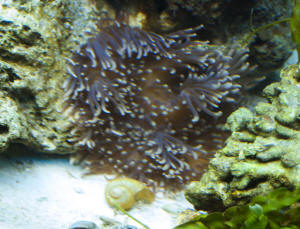
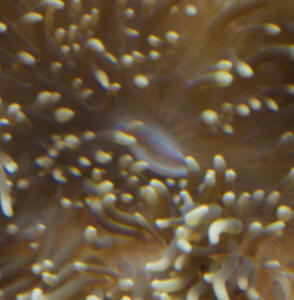 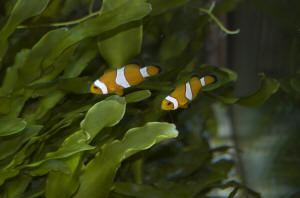 |
|
Re: Bleached anemone follow up and id
8/13/2009
Hi Crew!
Hi Mr Fenner!
<Claire>
Good morning to all of you...
<We'll see; if and when I wake up>
Thank you very much for your fast answer and for the ID of the
anemone.
I am very comforted to see that the care for the bleached anemone
has positive results in the meantime. About the ocellaris clowns,
I had read all the FAQs and the articles concerning these little
guys on your site before asking you, but you know the anxiety of
new marine aquarists...
After your answer, and seeing that they would not still eat
nothing, I decided to apply the same politics that I follow with
my best friend, my cat (15 years old now). I stopped to give them
any food for two days, as I do not want overload my tank with
organic matters.
<Ahh!>
I tried yesterday
night again, and this time they came happily to eat (I shut power
heads and auxiliary pump before). They just had their meal now
and were ravenous, so I think this problem is solved. I just will
have to be very patient (very difficult thing indeed for me) to
let them settle down and find a suitable spot, anemone or
not.
<Patience is indeed a virtue at times>
Thanks again for all your help!
Claire
<And you for sharing. BobF>
|
|
Anemone Identification Likely a Long Tentacle Anemone
(Macrodactyla doreensis) 4/28/2009
<H>ey,
<Hello>
<I> bought this "anemone" last week and <I>
wanted to know what kind it is.
<It is an anemone>
<I> was told by the LFS that its was a long tentacle
anemone.
<It appears to be a LTA>
I posted some pics on another forum and someone had said it
looked like it was a plate coral,.
<Not even close>
but another member of the forum said he didn<'>t know
what it was but it didn<'>t look like a anemone.
<They were wrong>
<H>e ask<ed> if the base of the anemone was reddish.
<I> told him it was and took a pic for him to see.
<H>e then said that he was pretty sure it was an anemone.
<I> just wanted to ask <yo>u guys what <yo>u
think it is.
<I>t looks very much like a long tentacle plate coral.
<T>ell me what <yo>u think.
<T>h<ank -x>s
<It is a Long Tentacled Anemone (Macrodactyla doreensis) You
can read about their proper care here:
http://www.wetwebmedia.com/macrodoreensis.htm As well as the
linked pages at the top Do realize that LTAs do not like living
on rocks, but rather in sand\mud.
Also, in future correspondence, please use proper grammar rather
than
"netspeak".>
<Mike>
|
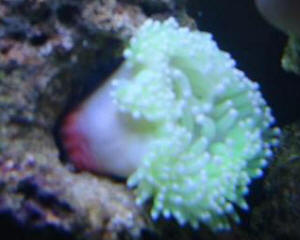 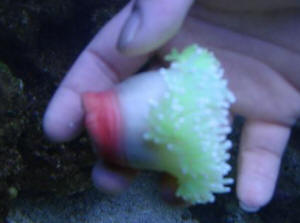 |
|
Anemone noob, help please! LTA -- 07/01/07 Recently, I was
given an entire salt water present as a gift. <Wow!>
Although I've always been interested in and loved marine
life, I was so unprepared for something of this caliber. Oh, and
to complicate matters even further, I was also given an anemone.
So, my tank consists of 2 blue damselfish, 1 clownfish and a
non-hosting anemone. I was told that it is a "long
tentacle" anemone, but it doesn't have the thing looking
tentacles that I see in most of the pictures. I'm very
concerned about my anemones' health. <Is an LTA,
Macrodactyla doreensis... from the shape of the tentacles,
radiations from the disc out to/on the tentacles...> I have
been feeding it small pieces of frozen silversides, <Need to
be small... less than a quarter inch...> since the clown fish
isn't hosting in it and I've read that hosting anemones
get a majority of their food from their guests (?). <No... a
myth... Need bright light/photosynthesis and purposeful
feeding> I'm attaching a picture, but I don't know how
the color will be. The anemone has a red base, <Another ID
clue...> but is buried in the sand currently. <Is where
this species lives... in muck actually> It has a pink-red
almost translucent color, but the ends of the tentacles appear to
be greenish. It also has white stripes coming out from its mouth.
<Good description> I guess my question is, is my anemone
okay? I maintain the pH & temperature, regularly test
nitrite, nitrate and ammonia. Oh, and the tank I have is only 12
gallons. It's an AquaPod, but I was not given a manual or
anything for it so I am really unsure about the lighting.
http://www.current-usa.com/aquapods.html is the website, giving
the following as lighting specifications for the 12 gallon model
"1x27w SunPaq | Dual Daylight & 1x27w SunPaq | Dual
Actinic" It has a blue and a white light, as well as an LED
light. I keep the blue and white on during the day, and just the
LED while I sleep. <Appears okay thus far> I also think my
anemone might be splitting.. Either that or it has just decided
to become misshapen with haphazard tentacles. I'm confused as
to why it would split though. Thank you so much for your time.
-Lezlie p.s. Sorry for the excess of pictures, I'm not sure
which one depicts my anemone from the most helpful angle. <No
worries, and we're in "luck"... I just finished a
survey article re this species... yesterday: Please read here:
http://www.wetwebmedia.com/macrodoreensis.htm and the linked
files above. Bob Fenner>
Anemone help- the forgotten (unimportant?) details... --
07/01/07 In addition to the clownfish, 2 damselfish and
anemone, I also have 3 snails, a peppermint shrimp and 3 hermit
crabs. I maintain the temperature around 80 degrees and the pH
around 8.3. The tank was cycled for quite a while before anything
was introduced. <Good> Live sand and some live rock
(I'm unsure of the exact amount because this was all down
before I knew of the tank). Terribly sorry to bother. The site is
amazing, I wish I had known about it way earlier! Thanks again,
Lezlie
<Welcome my friend. Bob Fenner>
|
|
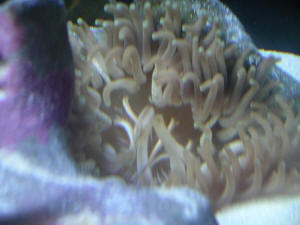
|
Anemone ID 12/10/06 Hey crew, <Hey
now, Mich with you tonight.> Wanna take a gander and throw your
hat in the ring as to what I have here? I am leaning toward a BTA
or LTA, but I am not sure. This guy just came out of some live rock
I got in. <My vote is LTA. Where did the rock originate?>
Thanks,
<Your Cj |
|
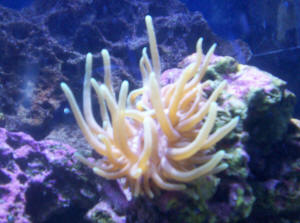
|
| Identifying an Anemone 11/11/05 Hello Bob, thank you
very much for replying!! <Welcome> My question regards trying
to identify an anemone I have. I am pretty sure it is an LTA, as
these are the only ones I can find on the web that resemble mine. I
have attached some photos so maybe you can tell me if I am correct.
<Is a Macrodactyla doreensis:
http://www.wetwebmedia.com/marine/inverts/cnidaria/anthozoa/anemones.htm.
One of whose common names is the LTA, yes> Also I am having a
rough time placing this little guy. (seems common with LTA
anemones, another reason I'm thinking that's what this
is...) he always seems to end up in live rock "caves" or
face down in the sand. Right now I have him on the substrate with a
clear plastic bowl over him with holes drilled in it, which gives
him just enough room to spread out and move around a little.
Anything else I should do?? <Mmm, best to "nestle" in
an opening twixt two or more rocks...> I have read that LTA like
to be in the substrate, not on the rocks. Am I correct? <Yes>
Also, he has no tears to his foot, appears very vigorous and
healthy, and eagerly devours any shrimp or squid I give him 1-2
times a week. I have had him for about three weeks now. I have a 30
gallon tank with 25 Lbs. of live rock, ammonia is 0, nitrites 0,
nitrates very low, pH of 8.3. I also use Phosguard by Seachem to
control phosphorous/algae, and I supplement with calcium/magnesium,
and add phytoplankton. I have 3 Damsels (still there from cycling),
and a True Percula Clown, which absolutely loves the anemone. Also
I have a Peppermint Shrimp, and some Blue Legged Hermits for algae
control. My only coral so far is a patch of purple and green
Zoanthids that came in on some LR. My substrate is 1.5 inch deep
very finely crushed coral. Any help you can give me will be greatly
appreciated!! Thank you very much Eric <About all we have
written re is posted on WWM... please see the link above the
citation above... Bob Fenner> |
|
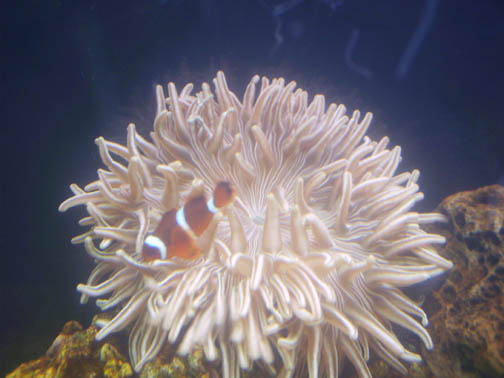 
|
|
|

